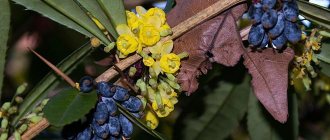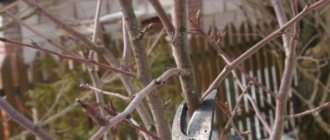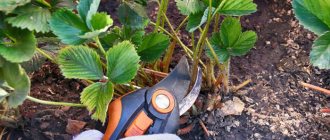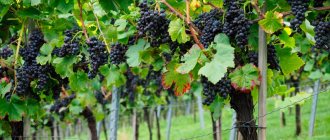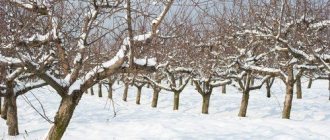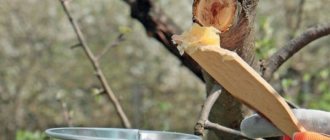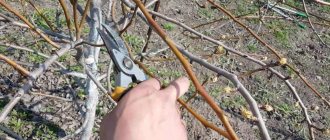Is pruning necessary?
Caring for barberry in the garden includes pruning. Many novice gardeners do not understand whether this procedure is mandatory or not. This largely depends on the type of pruning itself:
- sanitary cleaning should be done every year so that the plant does not waste energy and nutrients on dried or painful branches;
- shaping is done solely at the request of the gardener and his plans for the shrub;
- Anti-aging is recommended to improve the decorative qualities of the bush.
Barberry in open ground
Depending on the gardener’s plans, it is worth deciding in which cases pruning is required and in which cases it can be avoided. Without proper care, ordinary barberry will quickly spread throughout the entire area due to the possibility of reproduction through root suckers.
Important! When pruning, it is necessary to protect your hands from sharp thorns. To do this, you need to prepare thick gloves. It is recommended to sharpen the tool well (it is advisable to use one with long handles and thick blades), since the branches are quite strong.
How to prepare barberry for winter
The amount of work depends on the variety grown on the site. For frost-resistant barberry species, preparation for winter consists of feeding and pruning. Hybrid varieties need some care in the fall.
Is it necessary to cover barberry for the winter?
Varieties such as Golden Rocket, Red Pillar Juliana, Aurea, Green Carpen need insulation for winter pruning. It is mandatory to organize protection for young bushes or plants that have suffered from diseases and have undergone anti-aging pruning.
It is necessary to cover the following varieties of barberry for the winter: Thunberga, Harlequin, Maria, Orange Rocket, Rose Glow, Bagatelle.
How to cover correctly
After pruning, removing debris and fertilizing, it is important to properly cover the bush. In the northern regions, even frost-resistant seedlings need protection.
Before covering the bush, after pruning it should be hilled up to a height of 12 cm, then the shoots should be tied into a single bundle.
The last step in preparing for winter is to use burlap or spunbond.
The material will need to be wrapped around the branches, secured with a rope so as not to damage the shoots
Anti-aging barberry pruning
Anti-aging pruning of barberry should be done in the spring. It is required for 8-10 year old plants, the decorative value of which has significantly decreased. Removing old shoots will give the plant new life, the plant will come to life before our eyes and within a year it will be possible to start forming shrubs.
Barberry Erecta - planting and care, description
After pruning, the shoots begin to grow vigorously. You can remove branches on any type of planting: both on a single plant and on a hedge or border. Trimming barberry involves removing all shoots.
Note! Old shoots should be cut off at the surface of the ground, and new shoots should be shortened to 1/3 of their length. The cut areas must be treated with antiseptic solutions to protect against fungal diseases.
Scheme of anti-aging pruning of barberry
What diseases should barberry be treated for in the fall?
Of the diseases, barberry most often suffers from fungal ailments, the most common of which are: powdery mildew; bacteriosis; rust; withering; leaf spotting.
Powdery mildew manifests itself in the form of a loose white coating that looks like mold and covers the shoots, leaves, and occasionally the berries of fruit bushes. If even minor lesions are not eliminated, then during the fall cleistothecia will form in these areas, in which the fungus will overwinter. To cure a plant from powdery mildew, you can treat it, as shown in the video, using an aqueous solution of foundationazole (15–20 g per 10 liters of water) or one percent colloidal sulfur. Spraying, as a rule, is enough to carry out once. Severely affected leaves, shoots and fruits of the bush should be removed and burned.
Barberry bacteriosis, or otherwise bacterial cancer, is accompanied by characteristic tumors (cancerous formations), cracks and growth of shoots. This disease begins with the formation on leaves, young shoots and petioles of harmless, at first glance, angular small (1.5–5 mm) watery dark spots, which soon turn dark purple. Moreover, leaves are affected at all ages and in the case of severe manifestations of bacteriosis, they fall off quite quickly. Then the spots on the branches become oblong, crack, and then in their place brown swellings and swellings form. This disease does not affect flowers and berries.
Bacteriosis of barberry
If bacteriosis appears at the top of the shoot, then it’s not so bad. You just need to trim off the affected section of the shoot. In this case, it is necessary to capture a slightly healthy part of the stem. If bacteriosis has developed in the lower part of the shoot adjacent to the trunk, then most likely the entire bush is doomed to death. Having removed diseased fragments of barberry, it is necessary to burn them, and treat the plant itself with Bordeaux mixture or another preparation containing copper.
Barberry growing near fields with cereals is usually infected with rust. This disease affects leaves. Small orange spots appear on their upper side, and red swellings (pustules) appear on the lower side. With severe infection, barberry leaves gradually dry out and then fall off. This disease must be combated by collecting and subsequently destroying the affected leaves, as well as treating the bushes three times with one percent solutions of copper-containing preparations (Bordeaux mixture, cuproxate) or colloidal sulfur. If the disease is at an early stage, it can be overcome. But if it has spread throughout the entire plant, then it will have to be completely destroyed, otherwise there is a high risk of infection and subsequent death of neighboring bushes and other crops nearby.
Wilting (tacheomycosis) occurs when a fungus from the genus Phasarium spreads through barberry. The disease manifests itself in premature wilting and drying of leaves, after which they fall off. It starts on one side of the bush and sequentially but quickly spreads to the entire plant. Barberry can only be saved by timely, short-term pruning of already affected parts of the crop, before the disease covers the entire bush and spreads to neighboring plants. Then all plantings must be treated with a one percent solution of copper oxide chloride or Bordeaux mixture.
Leaf spotting. The fungus that causes this disease rarely affects barberry. However, the harm it causes is expressed not only in the loss of the decorative appearance of the bush, but also in the disruption of biochemical processes, which leads to poor ripening of the shoots, which is why they can freeze in winter. Symptoms of infection with this disease are spots of various shapes and colors that form on the leaves. The foliage is first disfigured, and then dries out and falls off. This fungus must be combated by treating the bushes with an aqueous solution of copper oxide chloride (30–40 g of the drug per 10 liters of liquid).
Sanitary pruning of plants
Barberry Thunberg Atropurpurea - description of the variety
Sanitary pruning of barberry is carried out annually. In the process, you can also begin to form a crown. It is recommended to trim only healthy shoots, but do not be too zealous. Weak branches are removed completely.
The crown can be formed only in the second year of the plant’s life. In this case, it is worth familiarizing yourself with the diagram in order to make the correct haircut and not damage the flower. The procedure should be carried out in the spring, before the buds bloom, and before winter, when the harvest has already been harvested.
Next spring it is recommended to shorten the shoots to 10 cm above the ground. The procedure will increase the density of the bush, it will begin to branch. At the 3rd year of life, 15 cm of shoots are left above the soil level. For a single plant, this method of cutting barberry will allow it to be kept in a ball shape for a long time. Border plantings and hedges require this procedure.
Scheme of sanitary pruning of barberry
How to form barberry in the first years after planting
Barberry is generally not difficult to prune. Even a beginner can easily cope with this task (unless, of course, he wants to give the bush some exotic shape). In the first year, immediately after planting, all weak shoots are removed, and strong shoots are shortened to a well-developed bud. By autumn the bush gives growth and begins to branch.
The simplest way to form barberry is in three stages, as a result of which a moderately spreading bush is formed
For more abundant branching (giving the bush a rounded shape), in the second year in the spring the shoots are “planted on a stump” - they are cut low, leaving stumps 9–10 cm high. In the fall, a wider, dense crown of young shoots is formed. From the third year this procedure is repeated, but each time the stumps are made higher than in the previous year. You can neglect repeated planting on the stump, and limit yourself only to regular sanitary and thinning pruning.
Barberry reacts calmly to pruning, but you should not shorten the shoots too much, especially if you are counting on a harvest.
Recent Entries
Lilac perennials that are beautiful, compact and do not crowd out other plants Why when buying seedlings you should not take the sellers’ word for it and how to determine the age of the plant using 3 signs Tomato seedlings have turned purple or whitish: why the color has changed and how to save the plants
To give it a specific shape, the bush is formed gradually, laying 3-4 skeletal branches in the first year, and in subsequent years, during pruning, leaving 1-2 more main branches. Thus, due to the natural difference in growth, it is possible to form a crown close to a pyramidal one.
Adviсe:
- Don't rush when pruning. Before “shredding” everything, carefully inspect the bush.
- Try to shorten the shoots to a well-developed bud.
- The cuts should be made at a slight angle and as close to the “eye” as possible to avoid stumps.
- The cut surface must be absolutely flat; jamming of the bark and burrs are unacceptable. If they are, it means you are cutting carelessly or using a blunt instrument.
- When removing side shoots, cut directly along the annular growth (the base of the shoot) - if you leave a stump, it will interfere with healing and provoke infections of the plant.
Formation of the correct crown
Thuja hedge - pruning and shaping
Formative pruning of barberry can be done in summer and spring. In the spring, haircuts are carried out after sanitary pruning. In this case, it is necessary to remove the shoots that thicken the bush. It is also worth cutting off those branches that are located close to the ground.
Additional Information! Barberry tolerates shearing well, and therefore you don’t have to worry about its condition after surgery. If you combine pruning with proper care, the bush will not experience stress.
In summer, 2 prunings can be performed. The first is held in early June, the second – after 2 months. In this case, it is worth using a template, since cutting barberry into a cube or ball is quite difficult by eye, since these are regular shapes. When cutting for the first time, choose the width and height of the bush, cut off the branches that extend beyond the boundaries of the template. Then the growing shoots are simply removed, but you should adhere to the given shape.
Important! In the first few years (about 5), barberry may not bloom. The procedure is carried out after the ovary appears, and the plants are trimmed manually with pruners or scissors. If the bush is old enough or occupies a large area, you can use electric scissors.
Scheme of formative pruning of a plant
Curly trimming
If you want to create sculptures from living plants, the shaping haircut changes to a curly one. It is held twice a year: at the beginning and end of summer. It is not difficult to form a barberry bush, since it does not require serious effort to obtain light geometric shapes.
For these purposes, guide rails are most often used, which are fixed vertically and horizontally around the bush in a certain size. Subsequently, branches that extend beyond the boundaries are pruned.
You can use not one plant, but several at once, to make it easier to create larger-scale structures. For a small cube, a couple of plants are enough, but if you need a larger size, then you should plant from 5 to 9 plants.
Additional Information! The most difficult thing is to form barberry with a ball, since you need a more complex design for the template. Most often, plywood or plastic is used, from which a semicircle is cut out and then attached to a pin. If this structure is rotated around its axis, it will form a ball.
After practicing on simple shapes, you will be able to create more complex ones. This is not very difficult. It is necessary to combine several simple shapes into one complex one, and then carry out the same procedures for curly trimming.
Curly pruning of barberry
Pruning barberry in spring and summer: features
The main difference between summer and spring pruning is the timing. In the spring, it is worth carrying out the procedure strictly before the buds appear so as not to harm the plant. In summer, decorative pruning can be done at any time, regardless of the month.
In spring, it is recommended to first trim those branches that did not survive the frost - they have dried out or rotted. In summer, only protruding branches that disrupt the overall picture are removed.
Important! If pruning was carried out due to the presence of pests or any disease, it is recommended to burn the branches immediately after cutting.
Is it possible to prune barberry bushes?
Barberry is a multi-stemmed shrub with thorns. Grows 3-4 meters tall if not limited. Due to numerous lateral branches it grows to the sides. The branches are spreading, so without regular pruning, the area will result in impenetrable thickets.
Another argument for the need for pruning: fruiting and flowering of barberry occurs exclusively on annual shoots. In the shade of strong thickening, berries do not appear. Also, pruning and thinning the bush is the prevention of fungal diseases by improving crown ventilation. Insects have less chance of harming the plant.
Care after pruning
Many people know how to cut Thunberg barberry, but not every gardener applies a number of measures that will help the plant recover after cutting. This is necessary for subsequent fruiting and growth.
Feeding
In the spring, after pruning, it is worth adding nitrogen to the soil. Each adult plant needs a bucket of organic matter, which is rotted manure or mature compost. It should be distributed in an even layer around the trunk. Gardeners often use fermented grass in liquid form for this purpose.
In summer and autumn it is worth adding potassium and phosphorus. These elements will allow the plant to better prepare for the upcoming cold weather. Substances can be found in inert flour or stove ash. If these fertilizers are not enough, it is also recommended to add a mineral complex.
After additional decorative pruning, you can apply liquid foliar fertilizer. In this case, you should use either potassium humate or the same fermented grass.
Cut care
If the sections have a diameter of more than half a centimeter, they need to be processed. Otherwise, fungal spores or insect larvae may enter the wounds. The infection will subsequently have to be treated for a long time, and if the diagnosis is delayed, the plant may even die.
Slice processing
You can coat the cuts with one of the following substances:
- garden antiseptic;
- garden pitch;
- oil paint;
- green solution.
If you properly treat the cut areas, they will be overgrown with bark in a short time, there will be no hollows in them, and they will not begin to rot.
Pest prevention
The most effective way to protect against pests is to treat branches and leaves with a soap solution. To prevent the development of various types of diseases, it is recommended to add colloidal sulfur and Bordeaux mixture to the soil. If spotting appears on the leaves, you should use products containing copper.
Barberry does not require constant care, but its use in landscape design requires constant trimming of the bushes, which is why at times you will have to arm yourself with tools with long handles and put on thick gloves on your hands. Don’t forget about proper care afterwards.
Selection and preparation of tools
Barberry has many long and prickly thorns. To cut it you need to prepare the tools:
- Garden scissors with long blades.
- Metal scissors.
- Sharp pruning shears with double-sided or single-sided sharpening.
- Lopper with long handles.
- Brush cutter mechanical or electric.
- Electric scissors and chainsaws.
- Gloves and jacket made of thick protective fabric.
- A saturated solution of manganese or carbon black.
- Garden var or special garden paint.
You need to purchase high-quality tools that are not heavy and can withstand loads. They should be brightly colored so that they are clearly visible among the branches.
All tools must be in good condition. Cutting elements with narrow ends will help you get to the very base of the plant. The blades must be sharpened at the correct angle. Dull and improperly sharpened tools injure branches and split them at the cut points.
